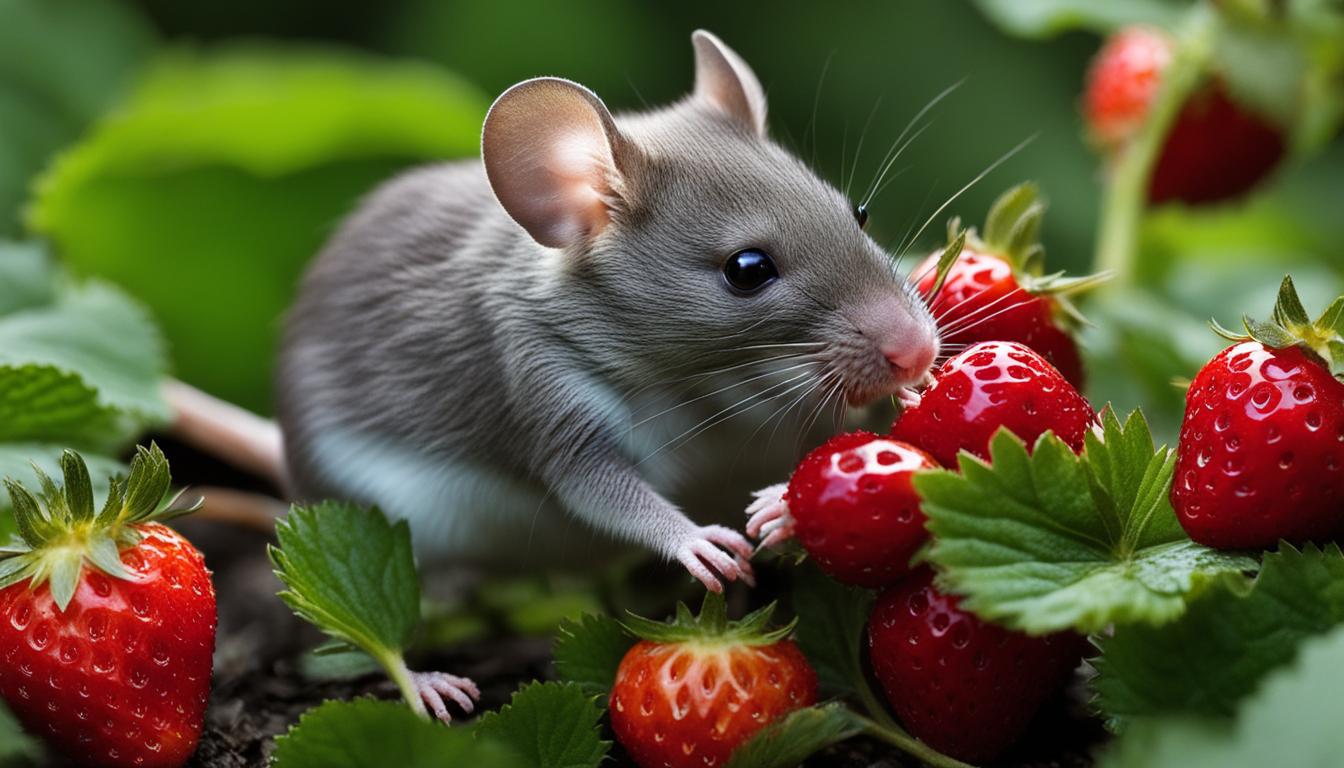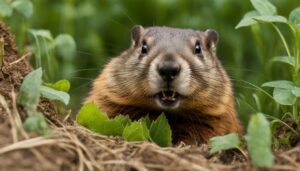Mice are fascinating creatures that capture our curiosity with their adorable appearance and nimble movements. But when it comes to their dietary habits, many people are left wondering: do mice eat berries? In this comprehensive guide, we will explore the eating habits of mice and answer all your questions about their love for berries.
Key Takeaways:
- Mice are omnivores and require a balanced diet for optimal health.
- Berries are a nutritious addition to a mouse’s diet, providing essential vitamins and minerals.
- It’s important to offer a mix of fresh fruits and vegetables to fulfill their dietary needs.
- Providing a stimulating feeding environment with opportunities for foraging can enhance a mouse’s well-being.
- Remember to offer treats in moderation and consult a veterinarian for specific dietary recommendations for your pet mouse.
Mouse Dietary Requirements and Recommendations
When it comes to the dietary requirements of mice, it’s important to understand their natural diet and eating preferences. Mice are omnivores, meaning they have both plant and animal matter in their diet. While they may eat a variety of foods, including berries, it’s crucial to provide them with a balanced and nutritious diet.
A mouse’s diet should consist of a combination of fortified pellets, fresh fruits and vegetables, and occasional treats. The pellets should make up the majority of their diet, providing essential vitamins, minerals, and nutrients. Offer a variety of fruits and vegetables that are safe for mice to consume, such as apples, pears, bananas, and of course, berries.
Nutritional Requirements of Mice
When considering the nutritional requirements of mice, it’s important to note that their needs may vary depending on factors such as genetics, activity level, and life stage. However, in general, mice require specific amounts of potassium, phosphorus, calcium, sodium, iron, manganese, and other vitamins and minerals per kilogram of food. This is why it’s crucial to offer a balanced and varied diet that includes a mix of pellets and fresh foods.
By providing a diverse diet that includes berries, you can help satisfy a mouse’s natural foraging instincts. Scatter their daily amount of pellets around their cage to encourage foraging behaviors. You can also hide treats like hay and vegetables inside paper bags or cardboard tubes to provide mental stimulation. In addition, offering safe items for mice to chew on, such as cardboard and untreated softwood branches, helps keep their teeth healthy and prevents boredom.
| Food Type | Percentage of Diet |
|---|---|
| Fortified Pellets | 75% |
| Fruits and Vegetables | 20% |
| Treats | 5% |
Remember, mice have specific dietary requirements, and it’s essential to provide them with the proper nutrition for their optimal health and well-being. By understanding their natural diet, incorporating berries and other fresh foods, and creating a stimulating feeding environment, you can ensure that your pet mouse leads a healthy and happy life.
Choosing the Right Food for Your Pet Mouse

When it comes to feeding your pet mouse, it’s important to choose the right food that provides the necessary nutrition. Mouse-specific diets, such as mouse and rat pellets or blocks, are a great option as they contain the required vitamins, minerals, protein, and other essential nutrients. These specially formulated diets ensure that your pet mouse gets a well-balanced meal and meets its dietary needs.
Avoid feeding your mouse seed mixes, as mice tend to pick out their favorite items and may not consume a balanced diet. While mice can enjoy a variety of fruits and vegetables, it’s essential to avoid offering them foods that are high in fat and sugar, such as candy, cookies, peanut butter, chocolate, and bacon. These foods can be harmful to their health and lead to obesity and other health issues.
Don’t forget to provide your pet mouse with fresh, clean water at all times. Ensure that the water container is easily accessible and regularly cleaned to prevent contamination. Discard any uneaten food to prevent spoilage and maintain a clean feeding environment for your mouse.
Table: Foods to Avoid Feeding Your Pet Mouse
| Foods to Avoid | Reason |
|---|---|
| Candy | High in sugar, can cause obesity and dental issues |
| Cookies | High in fat and sugar, can lead to obesity |
| Peanut Butter | High in fat, can cause choking hazard |
| Chocolate | Toxic to mice, can cause severe health problems |
| Bacon | High in fat and salt, can cause digestive issues |
By selecting the right food for your pet mouse and providing a balanced diet, you are ensuring its overall health and well-being. Remember, a healthy diet contributes to a happy and active mouse!
Tips for Feeding Your Pet Mouse
Feeding your pet mouse a proper diet is essential for their overall health and well-being. Here are some tips to help you provide the best nutrition for your furry friend:
1. Offer a balanced diet:
Provide a mix of fortified pellets, fresh fruits, and vegetables to ensure your pet mouse receives a balanced diet. The pellets should make up the majority of their food, while the fresh produce adds variety and essential nutrients. Remember to rotate the types of fruits and vegetables to keep your mouse interested and stimulated.
2. Monitor food intake:
Offer a small bowl or plate with fresh food daily and monitor how much your pet mouse eats. This will help you ensure they are consuming an adequate amount of food and prevent them from consuming spoiled food. Remove any uneaten food to maintain cleanliness and prevent spoilage.
3. Provide occasional treats:
While treats should only make up about 5% of your mouse’s diet, offering occasional treats can be a great way to provide extra enrichment and reward your pet. Cereal, seeds, and crackers can make suitable treats, but be sure to offer them in moderation.
4. Adjust food intake for specific needs:
Pregnant, nursing, and growing mice may require increased food intake. Monitor their weight and consult with a veterinarian to ensure they are receiving enough food to support their specific needs.
| Food | Amount |
|---|---|
| Fortified pellets | Majority of the diet |
| Fresh fruits and vegetables | Rotate types for variety |
| Treats (cereal, seeds, crackers) | 5% of the diet |
By following these tips and providing a nutritious and varied diet, you can ensure that your pet mouse stays healthy and happy.
Creating a Stimulating Feeding Environment
Mice are naturally curious and have a strong instinct to forage for their food. By creating a stimulating feeding environment, we can help satisfy their natural behaviors and promote their physical and mental well-being.
To enhance their foraging experience, scatter their daily amount of pellets around their cage. This mimics their natural habitat, where they would search for food in various locations. It also encourages physical activity as they move around to find their food. Additionally, you can hide treats like hay and vegetables inside paper bags or cardboard tubes. This provides mental stimulation as they have to work to access their rewards.
In addition to creating a foraging environment, it’s important to provide safe items for mice to chew and gnaw on. This helps keep their teeth healthy and prevents boredom. You can offer cardboard, coconut shells, hay cubes, and untreated softwood branches. These items provide a variety of textures and flavors for mice to explore.
Examples of Safe Chew Toys:
| Item | Description |
|---|---|
| Cardboard | Empty toilet paper rolls or small boxes |
| Coconut shells | Empty coconut shells with the fibers removed |
| Hay cubes | Compact cubes made from compressed hay |
| Untreated softwood branches | Suitable branches from fruit trees or other non-toxic wood |
Overall, creating a stimulating feeding environment for your pet mouse is essential for their well-being. By encouraging their natural foraging behaviors and providing safe chew toys, we can help keep them active, happy, and mentally engaged.
Conclusion
In conclusion, mice are omnivorous creatures that can indeed eat berries. While berries may be a tasty treat for mice, it is essential to provide them with a well-rounded and balanced diet. Fortified pellets, along with fresh fruits and vegetables, should make up the majority of a pet mouse’s diet, ensuring they receive the necessary nutrients for optimal health.
Although mice may have a preference for berries, it’s important to remember that they require a variety of nutrients to thrive. By offering a diverse range of fresh foods and rotating them regularly, we can provide mice with the variety they need while stimulating their natural foraging instincts.
While we’re on the topic of feeding mice, it’s worth mentioning that wild mice can also eat berries as part of their diet. However, it’s important to note that the dietary preferences of wild mice may differ from those of their domestic counterparts. The availability of food sources and the environment can greatly influence the feeding habits of wild mice.
To promote the overall well-being of pet mice, it’s crucial to create a stimulating feeding environment. By scattering their daily amount of pellets and hiding treats for them to find, we can enhance their physical and mental health. Additionally, providing safe items for mice to chew on, such as cardboard and untreated softwood branches, helps keep their teeth healthy and prevents boredom.
FAQ
Do mice eat berries?
Yes, mice can eat berries as part of their balanced diet. However, it is important to provide them with a variety of other nutrients as well.
What should a pet mouse’s diet consist of?
A pet mouse’s diet should consist of fortified pellets, fruits, and vegetables. The majority of their diet should be fortified pellets, with about 20% consisting of fruits and vegetables.
Can mice eat chocolate or other high-fat foods?
It is important to avoid feeding mice foods high in fat and sugar, such as chocolate, candy, and cookies. These foods are not suitable for their dietary needs.
How often should I offer fresh food to my pet mouse?
It is recommended to offer fresh food to your pet mouse daily. This allows you to monitor their food intake and ensure they are not consuming spoiled food.
How can I create a stimulating feeding environment for my pet mouse?
You can scatter their daily amount of pellets around their cage to encourage foraging behaviors. You can also hide treats and provide safe items for them to chew on to promote their physical and mental well-being.




